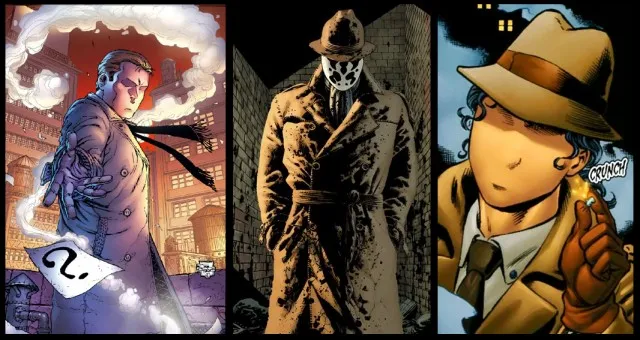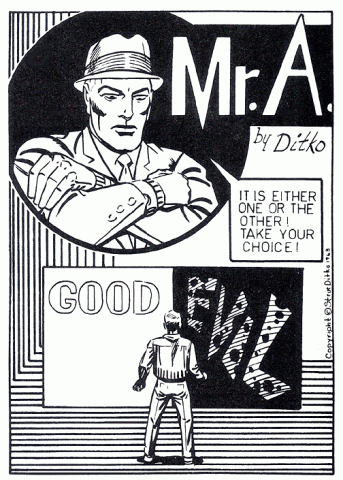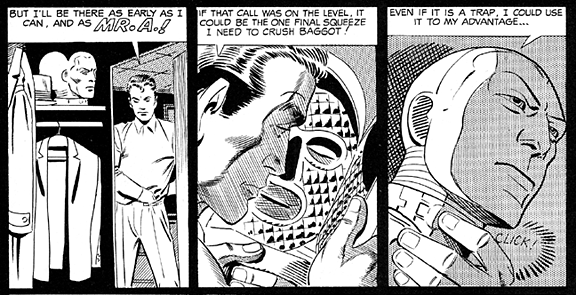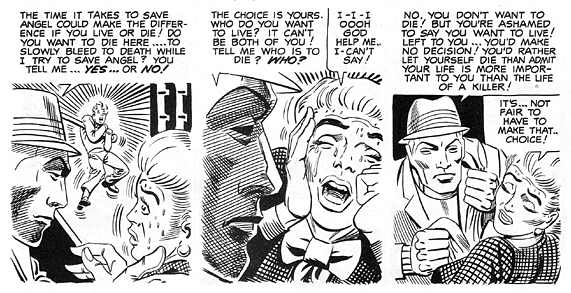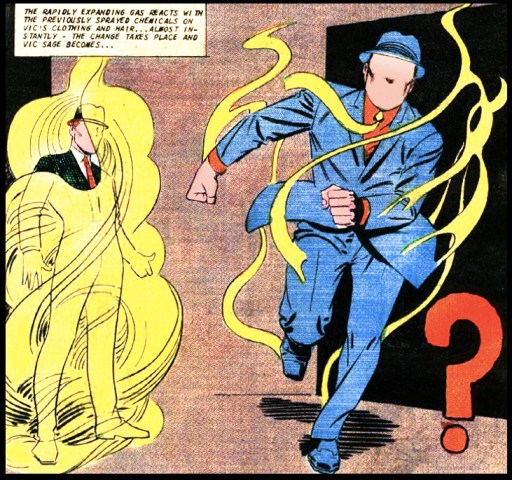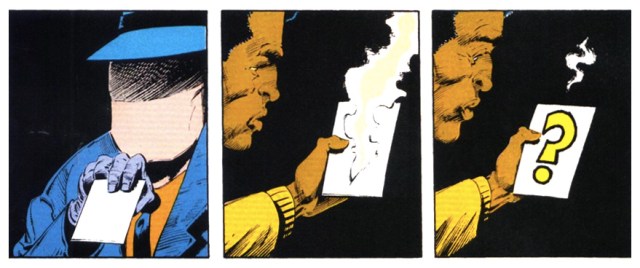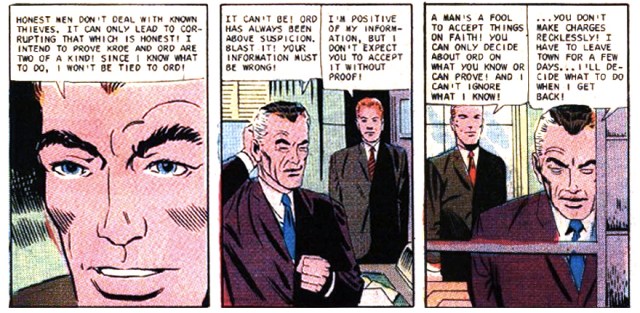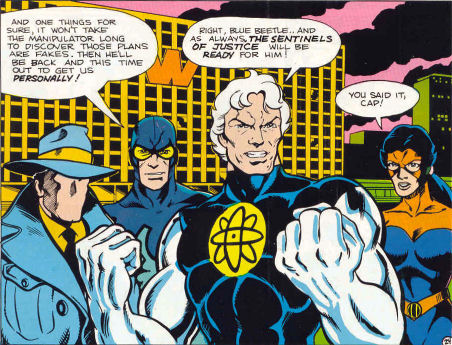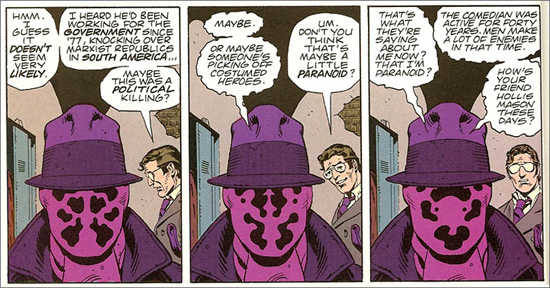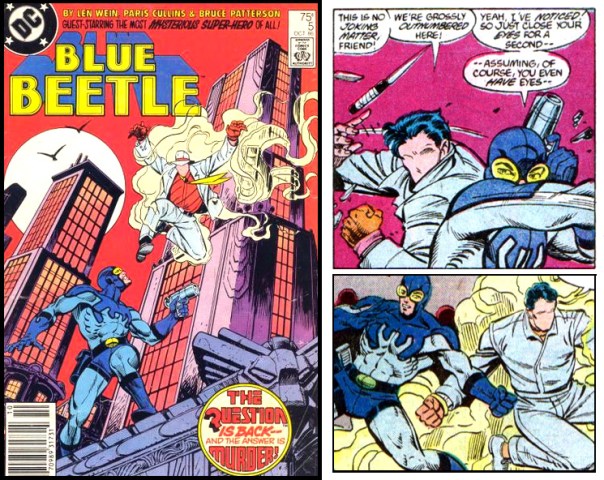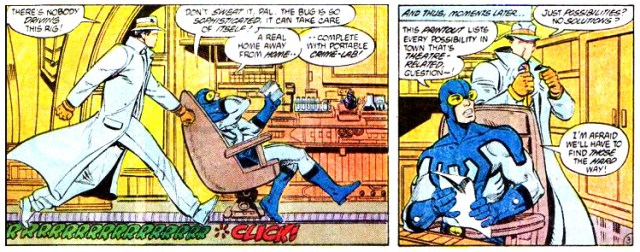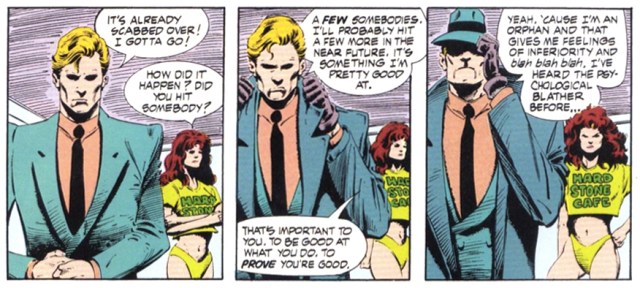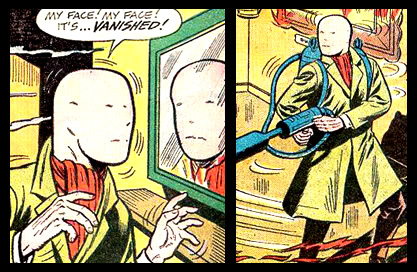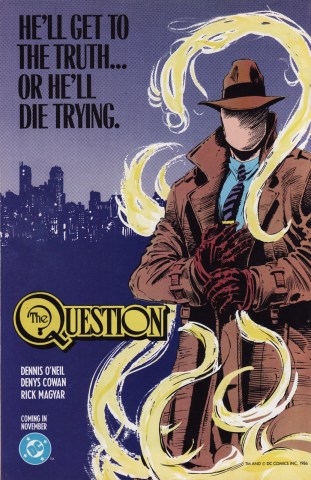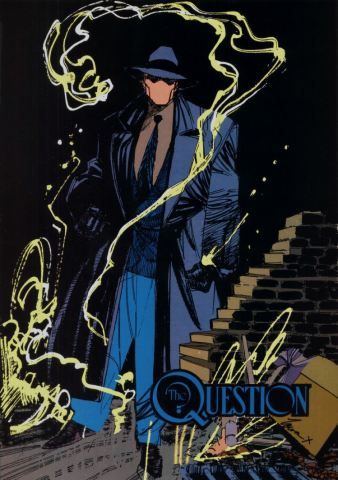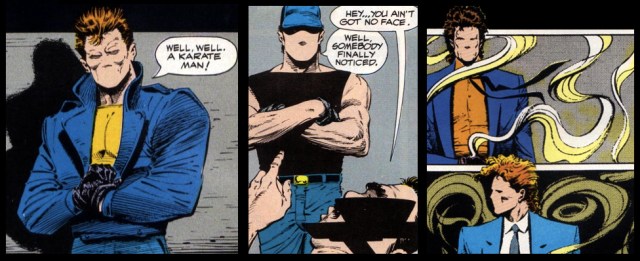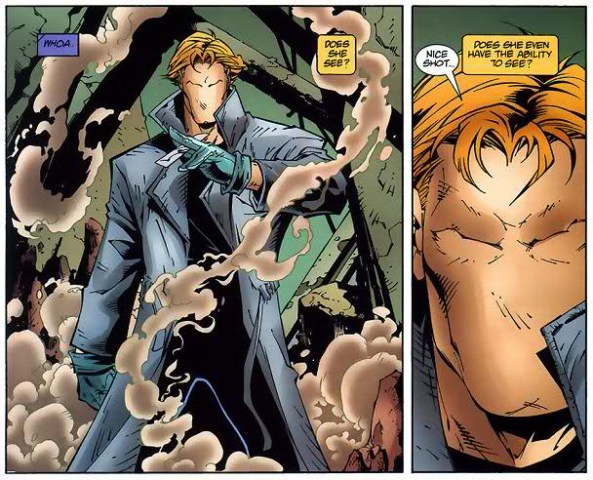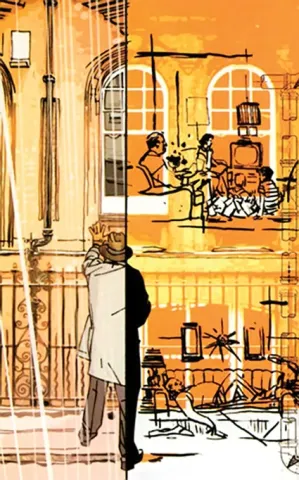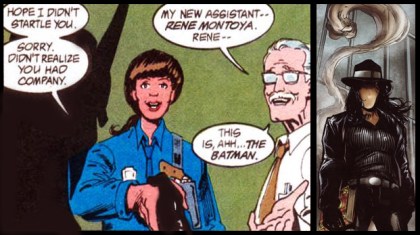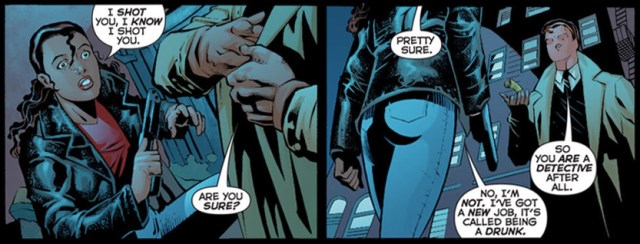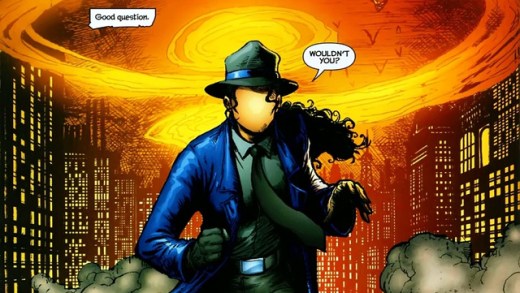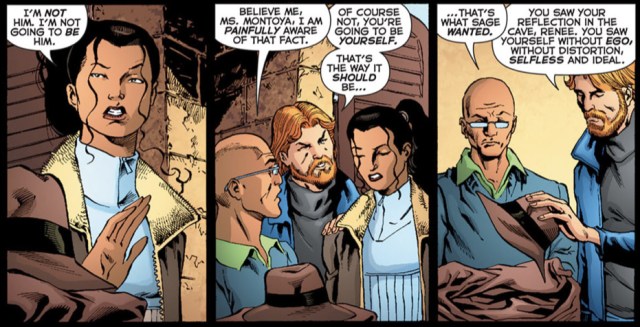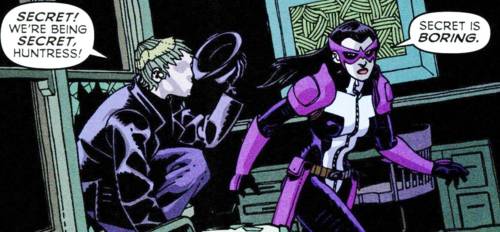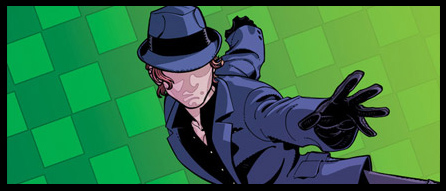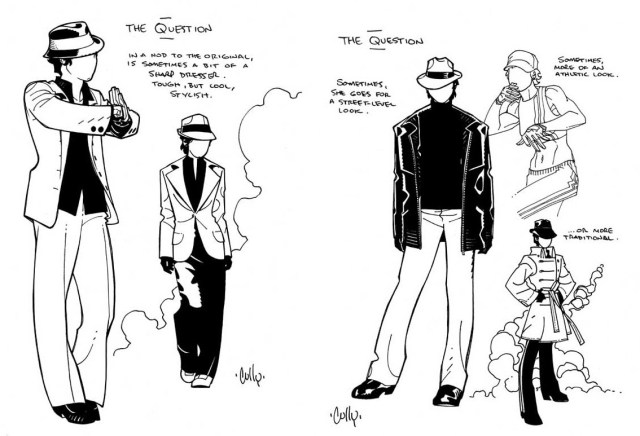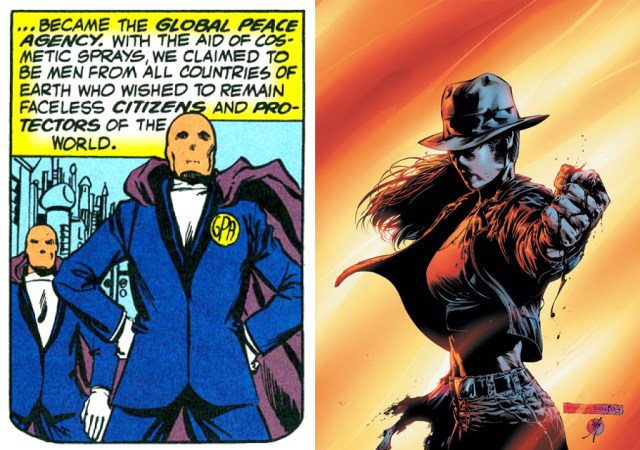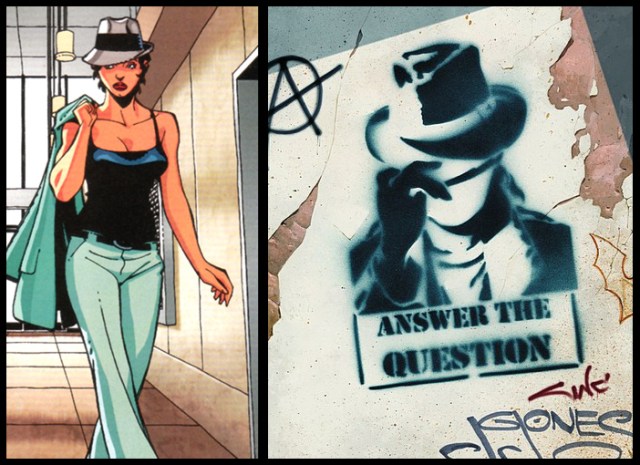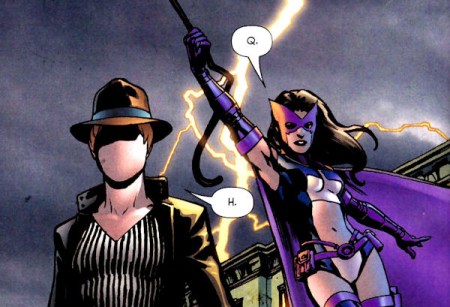There is a faceless vigilante who has stalked comics since the late 1960s. The legacy started with Vic Sage, a journalist who dedicated himself to fighting crime and exposing truth no matter what. It continued with Renee Montoya, a Gotham City detective who marveled at superheroes and then became one herself. Both of them, when wearing a faceless mask and a fedora, were called the Question. Who are they, and what is their connection to characters such as a certain near-forgotten Batman villain, the group called the Global Peace Agency, the violent vigilante Rorschach of Watchmen, and the strange man called Mr. A? Glad you asked. Read on!
THE COLD MASK OF MR. A
Before we delve into the Question, we should speak of a similar character also created by Steve Ditko. The mysterious Mr. A debuted in 1967 in the pages of Witzend #3, an underground comic that was released irregularly until the 1980s. Being an underground comic meant that Witzend didn’t worry about the Comics Code Authority and its rules concerning what made a comic safe for kids. Mr. A was really Rex Graine, a newspaper journalist sick to death of corruption and cowardice. He was a stoic man who believed that people needed to live up to moral absolutes. There were no extenuating circumstances for crimes, no justifications for breaking the law. Crime was Crime. A equals A.
Mr. A was inspired by Ayn Rand and her philosophy of objectivism, Ditko having become a fan of her work over the years. Her influential book Atlas Shrugged was published just ten years before Mr. A was created. Rand once said: “There are two sides to every issue: one side is right and the other is wrong, but the middle is always evil.” Similarly, Mr. A used a calling card that was half-black and half-white, saying there was good and evil and nothing in between. People who believed otherwise and spoke of shades of gray were people who invited the corruption of evil into their lives.
Mr. A had no origin. We had no explanation for why a journalist would become a vigilante. He wasn’t a character—he was a force of order unswayed by personal bias or emotion. Sometimes he fought crime as a journalist, other times as Mr. A, whose disguise symbolized his cold, unsympathetic nature. Along with a simple suit and fedora, he wore a metal mask with a frozen expressionless face and metal gauntlets. There was nothing “superhero” about this character. He was just a man who acted… and sometimes aided criminals to a fatal end.
The cold and sometimes cruel Mr. A didn’t inspire a huge fanbase. He appeared in less than a dozen short stories throughout the 60s and 70s. But the same year he first appeared, readers met another suit-wearing journalist/vigilante, also created by Ditko: the Question.
STEVE DITKO’S QUESTION
Vic Sage debuted in a back-up story of Blue Beetle #1, published in 1967 by Charlton Comics, and continued to appear in short back-up features over the next several issues. He was a crusading TV journalist whose station was considered a herald of truth and decency. Even the station’s head of PR was seen as a paragon of virtue by other people. But sometimes, Vic’s journalism wasn’t enough to stop evil. Sometimes he needed to operate as the seemingly faceless vigilante known as the Question.
The outfit is simple. Suit and tie, fedora, simple gloves, overcoat. It immediately puts the Question into the realm of detective stories and city corruption. This is a guy whom you can tell will spend most of his time fighting mobsters and crooked politicians instead of straight-up super-villains. Sometimes, Vic wore a turtle neck and loose jacket, which wasn’t quite as striking a look but was saved by the fact that he still wore that odd, faceless mask that has helped make the Question so memorable.
The mask was created by a scientist friend of Vic’s named Aristotle Rodor. Though it looked like blank flesh to others, it was a thin, collapsible disguise designed to let Vic see, breathe, and speak normally. A gas invented by Rodor caused the mask to adhere. The same gas, released from Vic Sage’s belt buckle, reacted with chemicals that had been sprayed on the journalist’s hair and all his clothing to cause a color change. Whatever clothes he wore, they always became pale blue, and his red hair always turned black. It only took a moment or two for Vic Sage’s special gas to turn him into the Question. Another gas agent caused the reverse effect.
Similar to Mr. A, the Question had a literal calling card, this one specially designed by Rodor. It would appear blank at first, but a moment after a criminal picked it up, a wisp of smoke would rise from it and a question mark would suddenly appear. How it worked wasn’t explained. I always assumed that it involved a heat-sensitive chemical agent that reacted to a person’s bare thumb and/or finger touching the card (whereas Vic’s gloved hands were insulated).
You might ask why Vic Sage called himself “the Question.” Was it a comment on how his job as a journalist focused on asking tough questions? Was it an existential ideal? Nope. From the looks of these original stories, it was just so that he could repeatedly say, “The Question wants answers!” Hey, it’s not the silliest reason a comic book character adopted a certain alias.
This Vic Sage didn’t exactly have dialogue with characters. He gave a lecture about justice, honor, and society just about every time he opened his mouth. He had no apparent interest in personal relationships, humor, or activities beyond fighting crime and injustice. He was more of an archetype than a character. We weren’t meant to think of him as a person as much as he was an instrument of faceless justice, unrelenting and incorruptible.
THE WATCHMEN
Charlton Comics stopped publishing superhero comics in the 1970s. In 1983 AC Comics published a story introducing the Sentinels of Justice, a team composed of the Question and fellow Charlton heroes Captain Atom, Nightshade, and Blue Beetle. In this adventure, the Question wore a trenchcoat rather than an overcoat, which I think suits him better. This incarnation of the Sentinels of Justice never had a second adventure.
The Charlton superheroes were then acquired by DC Comics. Alan Moore wanted to write a swan song for the Charlton characters, revealing that they had largely retired from superheroics in the 1970s (explaining why their stories stopped being published) and were now reunited by the death of a hero called Peacemaker. Since the Question had regularly appeared in back-up features of Blue Beetle’s comic before getting his own feature, the story would treat them as longtime allies.
Following the 1985-86 crossover Crisis on Infinite Earths, the superhero stories of DC Comics were rebooted and a new universe was introduced. DC wanted to integrate the Charlton characters into this new Post-Crisis universe and felt that Moore’s story, originally entitled Who Killed the Peacemaker?, would render them unusable. So Moore altered all of the characters into analogues of the Charlton characters. The Sentinels of Justice became the primary heroes of the 12-issue series now titled Watchmen. The Blue Beetle became Nite-Owl. Vic Sage aka the Question became Walter Kovacs aka Rorschach, a boy who had spent many years in the Charlton Home for Problem Children.
Rorschach didn’t use chemical and gas agents like the Question did, but he did don a trench coat, suit, and fedora along with a mask that completely disguised his features. The black and white designs on the mask that constantly alter but never mix or become gray recalls Ditko’s Mr. A.
Just as Captain Atom was overshadowed by his Watchmen analogue Dr. Manhattan, it is arguable that Rorschach’s fame has eclipsed the character for whom he was a stand-in. Popular fiction can be funny that way.
VIC SAGE, POST-CRISIS
The first Post-Crisis version of the Question showed up in Blue Beetle #5, published in 1986 and presented by Len Wein, Paris Cullins, and Bruce Patterson. This is fitting, since Ditko’s Question first appeared as a back-up feature in Charlton’s Blue Beetle. Rather than repeat the back-up feature idea, the Question actually appeared within the Blue Beetle’s story and helped him out on a multi-issue adventure.
This Post-Crisis version of the Question seemed just about identical to Ditko’s version, though perhaps a little less emotionally stiff and a little more human. He also was a big risk taker. At one point, he leaped out of the Blue Beetle’s aircraft and then surprised the other costumed hero by using acrobatics and specially insulated shoes to land safely rather than fall to his death. Readers then saw that the Question himself had no idea that this stunt would really work, but he’d been determined to impress the Beetle. You could almost wonder if the guy was an adrenaline junkie or had a bit of a death wish. That implication became an idea that was explored much further the following year in the new Question series written by Dennis O’Neil.
Critically acclaimed for his work on Green Lantern and Batman, writer/editor O’Neil, joined by artist Denys Cowan, reimagined the Question for the Post-Crisis DC Comics universe. The new series lasted from 1987 to 1990. The DC Comics Question was still a TV newsman named Vic Sage, but he had been born Charles Victor Szasz, an orphan prone to violence and questioning authority. Vic bounced around various cities, including Chicago and Gotham, until finally returning to his home of Hub City, a place that even Gothamites would called “Hellish.” He still knew Aristotle Rodor, who was now a not only a scientist but a philosopher who answered to the nickname of “Tot.” Rodor still supplied Sage with his mask and gas agents.
It was later revealed that this version of Rodor had originally developed the mask as a form of concealing bandage, called Pseudoderm, for people with burns and scars. In 2007, Mark Waid revealed that Psuedoderm’s development involved Gingold extract and technology recovered from the criminal Bart Magan. This was a very clever way of connecting the Question to other aspects of the DC Universe. Gingold extract, you see, is the chemical responsible for giving Ralph Dibny the elastic skin powers that made him the heroic Elongated Man.
Bart Magan was a much more obscure connection. He only appeared in one comic, Detective Comics #319 (1964), where he showed up as the faceless criminal who called himself, wait for it… Dr. No-Face! The story featured scientist Paul Dent inventing a rejuvenation ray that could smooth out wrinkles and completely remove scarring. A criminal named Bart Magan used the device on himself, hoping to remove a facial scar that made it easy for people and authorities to recognize him. But he messed up, and the ray smoothed out his entire face, leaving it blank. Magan then embarked on a new criminal career as Dr. No-Face, allowing people to believe that he was actually Dr. Paul Dent, who had accidentally removed his own face and gone insane. But Batman and Robin stopped Magan and he went to jail, where he no doubt creeped out prisoners who wondered how he could speak, breathe and eat without the presence of a mouth and nostrils. Not to mention the whole being able to see bit.
Vic’s gas agents worked the same way as they did in Ditko’s version of events, with a few minor tweaks. Rather than Vic spraying his hair with a special chemical, O’Neil decided that Rodor would be equipped with with a special shampoo that did the trick. Vic’s aftershave was a special concoction of Rodor’s as well. When the gas from Vic’s belt was released, it caused the aftershave residue on his face to act as a bonding agent with the mask, securing it in place. This chemical was designed for Vic’s body chemistry, and other chemicals such as nicotine could interfere. So Vic gave up smoking to ensure that his mask didn’t fall off at random times.
Initially, the Post-Crisis Question did have his hair turn from red to black when he donned his vigilante identity. Instead, it went from reddish blonde to a darker shade of red. It was sometimes tough to tell that a change occurred, as sometimes Vic’s hair didn’t seem different and his clothes occasionally just altered in shade rather than full color. This coloring element changed in later issues. In any event, I think the darker, more saturated blue makes the Question stand out better. It’s a lot more striking and intimidating than the pale blue he wore in his Charlton days. Still wish he wore sneakers rather than dress shoes and a trench coat rather than overcoat, but I guess it got cold.
O’Neil also used the Question’s calling card, but only for the first issue.
When we first met the Post-Crisis Vic Sage, he had been operating as the Question for a couple of years. He was a cynical man with no interest in “psychological blather” that sought to explain his actions or those of the criminals he fought. Basically, Ditko’s version but angrier. But then Sage had a near-death experience, followed by a visit from Batman. The Dark Knight confronted Sage with the fact that part of his reason for becoming the Question was because he didn’t know how else to feel excited about life outside of being in a fight. Batman accused Vic of having a death wish and told him that if he was truly going to lead this double life as a vigilante, then he had to truly dedicate himself to it and to a higher ideal. Vic then went to the countryside and trained under Batman’s ally Richard Dragon, a martial arts master.
Vic spent months learning martial arts and expanding his mind. Ditko’s version of the Question fought crime without hesitation, but now O’Neil’s Question sought to understand the motivations of those he fought and ponder what criminal activity indicated about humanity in general. He was a philosopher warrior who was very aware of his own capacity for violence. Batman didn’t kill for moral reasons. Vic Sage didn’t kill because he feared he might find himself enjoying it and then wanting to kill again. Years later, he did finally kill when he shot a criminal in order to save a child. He felt awful about the act, yet recognized that a small part of him wanted to do it again and relive the sense of power behind it. He decided never to use lethal tactics again.
During O’Neil and Cowan’s run, Vic didn’t always don a trench coat and suit. Whatever he was wearing could serve as the Question’s outfit. Maybe one day it was a muscle shirt and jeans. The next, a leather jacket. It was all good for the no-faced vigilante, though I still think the suit, tie and trench coat look work better. Starting in The Question #10, the gas now changed his reddish blonde hair to a dark shade of brown.
Despite some dedicated fans, The Question was cancelled in 1990. It was then followed by Question Quarterly, though this only lasted a handful of issues. Starting in Question Quarterly #2 (1991), Vic’s gas once again turned his hair black when he donned his disguise. After Question Quarterly ended, Vic showed up in different stories from time to time and got two one-shot specials: Azrael Plus The Question and The Question Returns. Still, none of these were enough for a new monthly series to start.
Most of Vic’s Post-Crisis stories were written by Denny O’Neil until 1998. That’s when Greg Rucka wrote a short story in Batman Chronicles #15, with pencils by Roger Cruz, inks by Sean Parsons, and colors by Pamela Rambo. In the story, the Question (now with his natural hair color showing and once again donning a trench coat) arrived in Gotham City and took an interest in Helena Bertinelli aka the Huntress. Often judged by Batman as too reckless and too harsh in her treatment of criminals, the Huntress resented the Question’s determination go give her advice and constructive criticism. But she found that she benefited from his lessons and the questions he asked. This set the stage for the two to become even closer in the 2000 mini-series Batman/Huntress: Cry for Blood.
Vic largely vanished again until Rick Veitch wrote a mini-series about him in 2005, where he turned Vic into more of a shamanic warrior. The gas he used to become the Question was now said to be hallucinogenic, giving him insight into the dreamtime and allowing him to access a higher level of knowledge to help his quest against evil. This new direction for Vic didn’t catch on. But by this time, the character became more popular due to his appearances as a detective and conspiracy theorist in the cartoon Justice League Unlimited.
THE LEGACY CONTINUES
Renee Montoya was created for the cartoon show Batman: The Animated Series but actually appeared in comics before any of her episodes aired. Her creators are Sean Catherine Derek (who won a Daytime Emmy for Outstanding Writing in an Animated Program for her work on Batman: TAS), Laren Bright (who also worked on The Pirates of Dark Water), and Mitch Brian (who co-wrote the series bible for Batman: TAS).
Debuting in Batman #475 (1992), Renee (first called “Rene”) was a new cop assigned to Gotham’s Major Crimes Unit. She was a little green but good enough at her job that she became a trusted aide to Commissioner Jim Gordon, who proudly introduced her to Batman. As time went on, Renee became a detective and continued to grow as a bad-ass. In the series Gotham Central, which focused on the GCPD, Renee was further developed by writers Greg Rucka and Ed Brubaker. One storyline dealt with her being outed as a lesbian and the consequences that followed, such as judgments from those she had deemed friends and having her family turn their backs on her.
At the close of Gotham Central, Renee lost her partner Crispus Allen along with a lot of her self-respect. She left the GCPD, falling into heavy drinking and self-destructive behavior. Which is when she was visited by the Question.
In the 2007 weekly series 52 (written by Greg Rucka, Mark Waid, Grant Morrison, and Geoff Johns), our boy Vic recruited Renee to help him figure out some strange mysteries. He also pointed out that she needed help in getting her act back together, despite her own objections. They worked as partners but also as mentor and student, with Vic guiding her as Richard Dragon had once guided him. Under Rucka’s direction, their journey led them around the world and into the lives of various villains and heroes. Along the way, they encountered the mythical city of Nanda Parbat and ran across old friends Aristotle Rodor and Richard Dragon.
In time, Renee discovered that Vic was dying of cancer. He finally died in Renee’s arms, leaving her terrified: While she now felt whole, she also wasn’t sure who she was without him. Vic pointed out that the real question was not who she was, but who she would become. Renee pondered this for days afterwards. What would have more power over her? Her fear or her curiosity? Some battles, some questions, could only be solved with a mask. To be the Question was to serve justice and truth without ego, agenda, or personal distortion, to be selfless and ideal. She was no longer a Gotham City cop and no longer a lost soul looking for purpose. She was the Question.
She was given a new mask designed by Rodor, one with a built-in adhesive layer that didn’t require a gas agent to cement it. She explained to him and Richard Dragon that she would not just be a copy of Vic, and they agreed that he wouldn’t have wanted that anyway. Renee needed to be a hero on her own terms. The gave her Vic’s most recent fedora and trench coat, and she embarked on her new path.
Renee quickly proved to be a a worthy successor. She maintained her street savvy and indulged in a sense of humor that the often introspective Vic had usually lacked. Renee went on to star in Greg Rucka’s mini-series The Question: Five Books of Blood, which featured her former lover Kate Kane aka Batwoman. She starred in several back-up features with the Huntress, who also mourned Vic’s passing.
Cully Hamner drew these back-up features starring Renee and made sure that she stood out as her own Question rather than just a woman copying Vic’s look. He made sure that Renee’s chin dimple still showed through the mask, making her Question face appear just a tad different to Vic’s (along with the noticeable skin tone and hair style difference). Whereas Vic’s shampoo and gas mixture turned his red hair black (except for those times it didn’t), Renee’s hair became lighter when she operated as the Question.
Vic’s Question looked like an old school version of a detective or reporter, while Hamner made Renee’s outfits a little more current, fashion-wise, and tailored them to her body. This was a sleeker, more stylish Question. The little touches worked very nicely and emphasized that Renee was continuing a legacy rather than simply following someone else’s path and identity. I think it definitely works better for her than Vic’s neck tie and trench coat.
Renee played an essential role in the crossover Final Crisis. In Greg Rucka’s tie-in mini-series Final Crisis: Revelations, she went against the immortal DC villain Vandal Savage, revealed in that story to be the inspiration for the story of Cain. The same story revealed that Renee was immune to having her free will removed by the powerful Anti-Life Equation, because she’s just that bad-ass and in control of her identity.
During the events of the main Final Crisis crossover, Renee is recruited by government agents who deal with supernatural, superhuman, and other weird phenomena. She winds up inspiring the creation of new faceless soldiers called Global Peace Agents. The Global Peace Agency had originally only been seen in the possible timeline depicted in Jack Kirby’s OMAC series in 1974. In that story, the GPA was made up of people who took on faceless identities to objectively protect all of Earth rather than one group, nation, or interest.
That is some fun cross-continuity there. Basically, if you lived in the DC Universe and were someone who wore a faceless mask (or were stupid enough to remove your own face with weird science stuff), you were sure to have a connection to the Question.
I personally kept hoping Renee would star in a full-on monthly series as the new Question. It could’ve been great. But in 2011, DC Comics rebooted its superhero universe, replacing its comics with 52 new titles. Many characters were reimagined, some in drastic ways. The Question became one of those latter cases. Just about everything we knew about the character was removed, except for his appearance.
In the New 52 reality, the man who would become the Question originally lived in ancient times and is one of three people who eventually known as the Trinity of Sin. The other two members are the woman Pandora (yes, that Pandora) and Judas aka the Phantom Stranger. A council of sorcerers judged the not-yet-Question guilty of terrible crimes, the details of which are still unknown, and as punishment they take away all memory of him from the world. They remove his face and sentence him to wander the Earth, unaging, obsessed with finding answers and asking questions. By the modern day, this faceless man is acting as a vigilante and has been nicknamed the Question. He’s not a journalist. He has no other identity. He doesn’t use scientific means to disguise himself. He actually is a guy without a face.
It’s weird enough how removed this mystical character is from the grounded vigilante that Ditko, O’Neil, and Rucka crafted. What’s more, Renee Montoya has not been seen at all in the New 52. I find that sad. Comics can seriously use a positive lesbian Latina hero. Along with that, I personally simply miss the old concept of Vic Sage as a journalist who decided to act. And I miss seeing how Renee grew as a character when she succeeded Vic.
Time will tell what further changes the Question may undergo and whether or not Renee will don the mask again. With that, we’ve wrapped up another article. Hope you enjoyed this. Comment with more suggestions for who else you want to see covered in Agent of S.T.Y.L.E.
SPECIAL NOTICE: This Friday, the collectibles shop Blast from the Past in Burbank, CA is hosting a ladies night starting at 7 pm. All geeks and geek allies are welcome to attend. There will be food trucks, and I will be there signing books. So come say hi!
Alan Sizzler Kistler (@SizzlerKistler) is an actor and freelance writer who moonlights as a comic book historian and geek consultant. He is amazed no one has made The Question into a live-action series yet. He’d be happy to do it himself. He is the author of Doctor Who: A History.
Are you following The Mary Sue on Twitter, Facebook, Tumblr, Instagram, & Google +?



